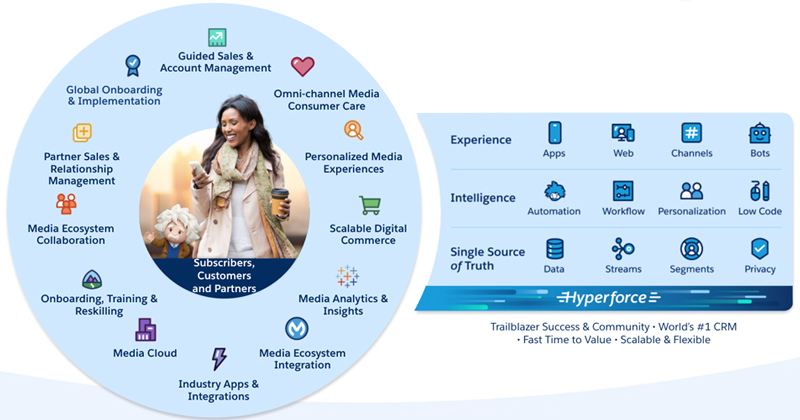New and innovative technologies are disrupting every space, and the media and entertainment industry is no exception. Big players in the space find themselves outside their comfort zone, for the customer they once knew and were able to attract no longer exists.
This industry is growing exponentially. OTT viewership saw a 30 - 40% growth at the start of the pandemic as people were constrained to their homes. And this trend is expected to continue with a growth of 20%, reaching 500 million users by 2023. As per Counterpoint Research, the country also witnessed a 55% YoY growth in 2021 in the smart TV space.
But this has not resulted in traditional channels losing a significant slice of their viewership. The DTH space also saw a growth of 5%, from 42% in 2019 to 47% in 2021.
So, what are some trends that industry players should watch out for in the coming year?
1. The linear - non-linear conundrum
The direct-to-consumer (D2C) pivot will continue to be the primary strategic priority for the industry. As expected, competition is intensifying. With OTT platforms expected to achieve a market share of 22% - 25% of India’s M&E industry by 2030, production studios are considering a foray into the non-linear OTT space since they own vast IPs. Aware of this emerging threat, OTT players are pouring money into developing content.
Additionally, while the shift to D2C might seem like the only focus for the future, industry players cannot afford to ignore linear channels. Broadcast and cable networks remain cash flow engines. To avoid an abrupt drying-up of revenues in this area, network owners must continue to direct fresh content to their linear channels.
So, for some time, networks will need to engage customers across both linear and non-linear channels, allowing them to choose one over the other.
Some industry leaders are already redefining themselves to beat the uncertainty. Traditionally, media companies had different teams to address the needs of advertisers on their cable and dish TV channels, and those of their non-linear channels. Today, with the help of AI, data insights and quotation tools, they are increasing their wallet share of the advertiser’s ad spend by bundling linear and non-linear ads.
2. Hyper-personalisation: The new ‘hyp’erpower
Content options and discovery are the key reasons why people prefer streaming services to traditional experiences. It has also now become a differentiating factor for customers to choose one subscription over the other.
In an environment where switching costs are low and consumers swamped with a growing collection of services, media companies need to deliver unique experiences to beat the competition. From sign-up to usage and billing, customers expect the brand to be present at and personalise every step of the way.
Operators that are able to intelligently capture customer preferences, and provide unique experiences and universal access to entertainment, will dominate the industry.
The rise in customer expectations has brought about an alliance between network owners, broadband providers and connected TV and phone manufacturers. These partnerships attempt to simplify, optimise and integrate layers and compatibility tools across platforms to deliver an increasing degree of personalisation.
Media companies with diversified businesses or innovative partnerships can take personalisation to a whole new level. The possibility of unlimited experiences becomes a reality when you mix content with shopping, gaming, devices, and other digital services. Imagine this - you watch a show, answer a simple question, and get a free delivery of the breakfast your favourite character eats on the show. This might soon become reality.
At the centre of this revolution will always be a Customer 360 view that is enriched every time the customer and the brand interact.
3. The birth of a new movie theatre experience
The movie business was one of the most adversely hit during the pandemic, with movie-goers staying away because of virus concerns. There was also limited availability of new movies. Movie lovers are now raring to go back to the big screen experience, as we can see from the collections of Spiderman: No Way Home, which crossed the $1 Billion mark globally.
The devotees of every genre will show up at their favourite venues, be it for cricket or football, movies, food, or shopping. However, the challenge will be to tempt the remaining 50-60% of people who fill up the seats, to step out.
This segment likes these experiences, but not enough to risk the wrath of the virus. They will return to these activities only once they have enough proof that their well-being is not at stake. Reassurances need to be shared periodically, reasserting that all is being done to ensure the safety of every customer.
What’s more, customer engagement will need to be redefined. It will no longer be confined to the touchpoints of buying tickets and the experience itself. But to everything in between as well.
Customer experiences will now cover areas that were previously never of concern, and this will demand an understanding of customer behaviour beyond the experience being provided. New alliances will come into existence, and new services will be bundled with one common goal of putting audiences back in their seats.
For example, a customer going to a movie theatre in a mall surrounded by some amazing shopping options, versus a movie theatre next to a row of fine dining restaurants is likely to end the evening with very different experiences. Also, do customers take a cab or their own car to watch the movie, do they go to their most frequently visited restaurant before or after the movie? Movie theatre chains today are investing in getting to know these dimensions, beyond the regular data like the genre of movies watched, a spike in the frequency of visits during a specific period in a year, and the number of members per visit.
How Salesforce can help
Salesforce Media Cloud, built on the world’s #1 CRM, extends CRM to your direct-to-consumer and business-to-business customers. Like all our offerings - Sales, Service or Marketing Cloud - Media Cloud too is built on top of the Salesforce Platform.
The Salesforce Platform enables you to innovate faster than ever before--in fact, customers report they’re able to develop apps 57% faster. This is because Salesforce Platform offers a suite of low code process automation tools, mobile-first technology, built-in collaboration and embedded AI.

Considering the times and industry needs, here are two solutions built on Media Cloud that can help media companies maximise customer lifetime value across their revenue streams:
Grow subscriber relationships
Consumers are more connected than ever and are subscribing to a variety of services that keep them entertained, connected, and informed 24/7. These services span from streaming entertainment, to digital news and digital assistants. Our Subscriber Lifecycle Management solution aims to grow your media subscription services business by helping you improve the experience at every point in today’s complex customer journey.
- Attract prospects, convert them into paying subscribers and seamlessly onboard them with Sales Cloud and Salesforce CPQ.
- Deliver omnichannel subscriber service by using our technology that enables you to be present at any touchpoint where a subscriber needs help. This includes both digital service with Experience Cloud and Einstein chatbots, as well as assisted service with Service Cloud.
- Retain subscribers using products like Einstein Prediction Builder and Einstein Data Discovery that predict the likelihood of churn and also of a customer buying a service or consuming a certain type of content. Build on these insights with Salesforce Marketing Cloud, launching smart campaigns to drive proactive retention journeys.
- Connect your diverse data sources with Mulesoft, our API management solution, and get rapid integration and re-use of APIs, to unify your various systems to deliver exceptional, connected customer experiences
Accelerate media sales
Media companies need to grow their ad sales business during this time of tremendous transformation. We help our customers by empowering them to launch new products and bundles with ease, by providing a single view across channels and interactions to understand advertisers better and sell more. The Advertising Sales Management solution helps ad sales organisations move fast in managing their complex ad sales businesses. Here is how the solution can help drive revenue, efficiency, and effectiveness:
- Grow pipelines faster by leveraging lead scoring with Sales Cloud, product bundling and revenue optimisation with Ad Sales CPQ, and automated marketing with Pardot.
- Drive operational excellence by allowing sellers to work from one platform.
- Amplify rep productivity by giving your team the tools to close business on the go.
- Sell smarter at every stage with Einstein, anticipating customer needs or spotting trends during a campaign.
As consumer behaviour in the entertainment industry becomes more unpredictable, it presents a great opportunity for companies to invest in solutions that help them understand this behaviour at a deep level, and even predict what consumers will expect next. With Salesforce Media Cloud, you can be present at every touchpoint, and use valuable data to create the tailored experiences consumers are looking for.





